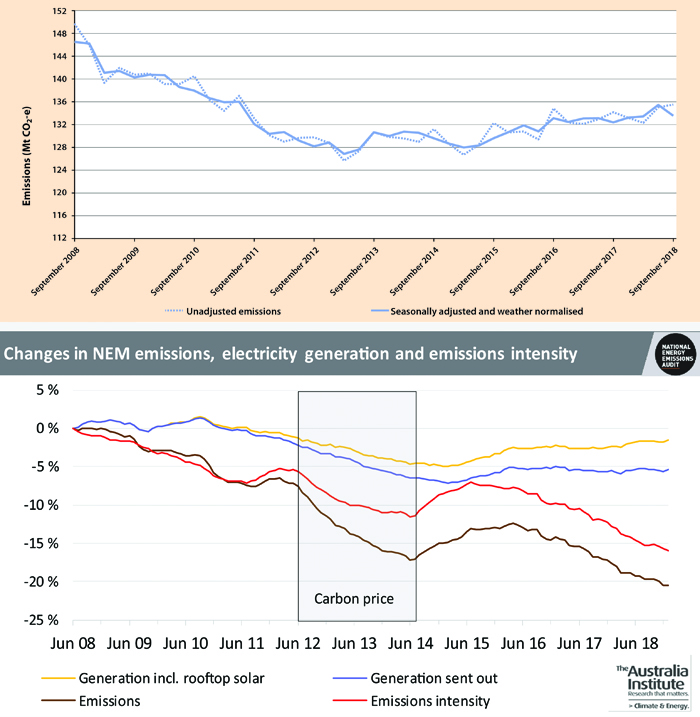The prime minister’s salesmanship faces its greatest test – climate change

Scott Morrison has never given much thought to climate change. That was obvious in 2017 when he clowned about with a lump of coal in parliament, mocking his opponents for their attitude to it.
Things were very different last week when the prime minister briskly and emphatically spruiked his party’s newly-packaged climate change policy, letting it be known he now takes this subject seriously. I bet we’ve seen the last of that lump of coal.
We should be pleased about this new-found enthusiasm for climate action, but I found it uncomfortable, to say the least, to sit in record-breaking autumn heat listening to the PM’s new line of argument in media interviews. Take his following responses.
“New Zealand to meet their targets will have to buy foreign carbon credits. Under our plan we don’t have to do that.”
And responding to the question, what would a projected 3C temperature rise by 2100 mean for Australia? – “The question really is, what is Australia’s role in all that? 1.3 per cent is our share of global emissions.”
Let’s unpick this. First off, while Australia exploits to the hilt unreliable, unmeasurable 1997 Kyoto credits to meet future targets, New Zealand’s bipartisan climate plan rejects them. It is absurd and hypocritical to imply our plan is better because we don’t buy overseas credits.
Our 1.3 per cent still puts us in the world’s top 20 emitters, where we rank second in emissions per person, behind only Saudi Arabia and nearly four times the world average. In the scheme of things, Australia is most definitely not one of the minnows.
More morsels from the Morrison spin: “We haven’t just come at this in the last couple of days. We’ve been at this for five and a half years, and we’ve been getting results.”
“These are the results that matter – a 1.1 billion-tonne turnaround in carbon abatement because of the policies we put in place.”
Scott Morrison’s defence of the indefensible knows no limits. As he tells it, Coalition governments have turned around a carbon abatement deficit at the end of Julia Gillard’s term of office and will beat 2020 and 2030 targets by hundreds of millions of tonnes.
That claim is false. The prime minister is using a sleight-of-hand devised and refined by Tony Abbott and his environment minister, Greg Hunt, which exploits a provision of the 1997 Kyoto Protocol allowing carbon credits for reforestation and avoided land clearing.
In 2014 Gillard’s carbon price scheme, which taxed measurable fossil-fuel emissions, was terminated by Abbott with the help of coal-mining MP Clive Palmer. In place of this functioning scheme, Abbott’s government set up the mistitled Emissions Reduction Fund.
Ignoring fossil-fuel emissions, the ERF sought instead to put a price on “imputed” emission reductions by paying people and corporations to do things like plant trees, avoid clearing land and change farming practices.
Under this regime, emissions savings – essentially just tonnages that it is agreed each project will save – are inherently unknowable, and the process opaque. Worse, we have no way of knowing whether the activities undertaken would have been done anyway, at no cost to the public purse.
Morrison says that the ERF and its rebadged, refinanced successor, the Climate Solutions Fund, are turning around a mess inherited by the Coalition. But his own government’s data say the opposite: that the Coalition created the mess by abandoning a scheme that was clearly working.
Quietly released last week, the data show that in the year to September 2018 Australian emissions continued rising as they have done ever since the end of 2014 – the year the Coalition abolished the carbon tax. Data for electricity emissions alone show an even more pronounced shift.
According to emissions-tracker Ndevr Environmental, multi-year data reveal that the government is heading for failure not just on its 2020 target, but also its 2030 Paris commitment, which it is on track to exceed by well over a billion tonnes of carbon dioxide.
Ignoring all this, Morrison sought to focus attention on a decline in September quarter emissions alone. Ironically this was driven by renewable power, much maligned by the government until now, which is steadily replacing a fading coal-power sector. Therein lies another fascinating twist.
The Coalition and its coal-wielding leader have been proposing to finance new coal power schemes, but now the PM is shifting the government’s position. Decisions about coal’s future, he said last week, “will be made within the energy market”. That, at least, is starting to get sensible.
Voters are right to be angry about the Coalition, but they should also treat Labor mitigation plans with caution. Australia must do the right thing by its people and the world and reject the downright fraud allowed by Kyoto credits. A risk-averse Opposition has yet to commit to this.
Faced now with the harsh reality of man-made climate change, the least we should demand from leaders is honesty. But as this sorry saga plays out, I fear we haven’t seen the last of the lies and spin.
